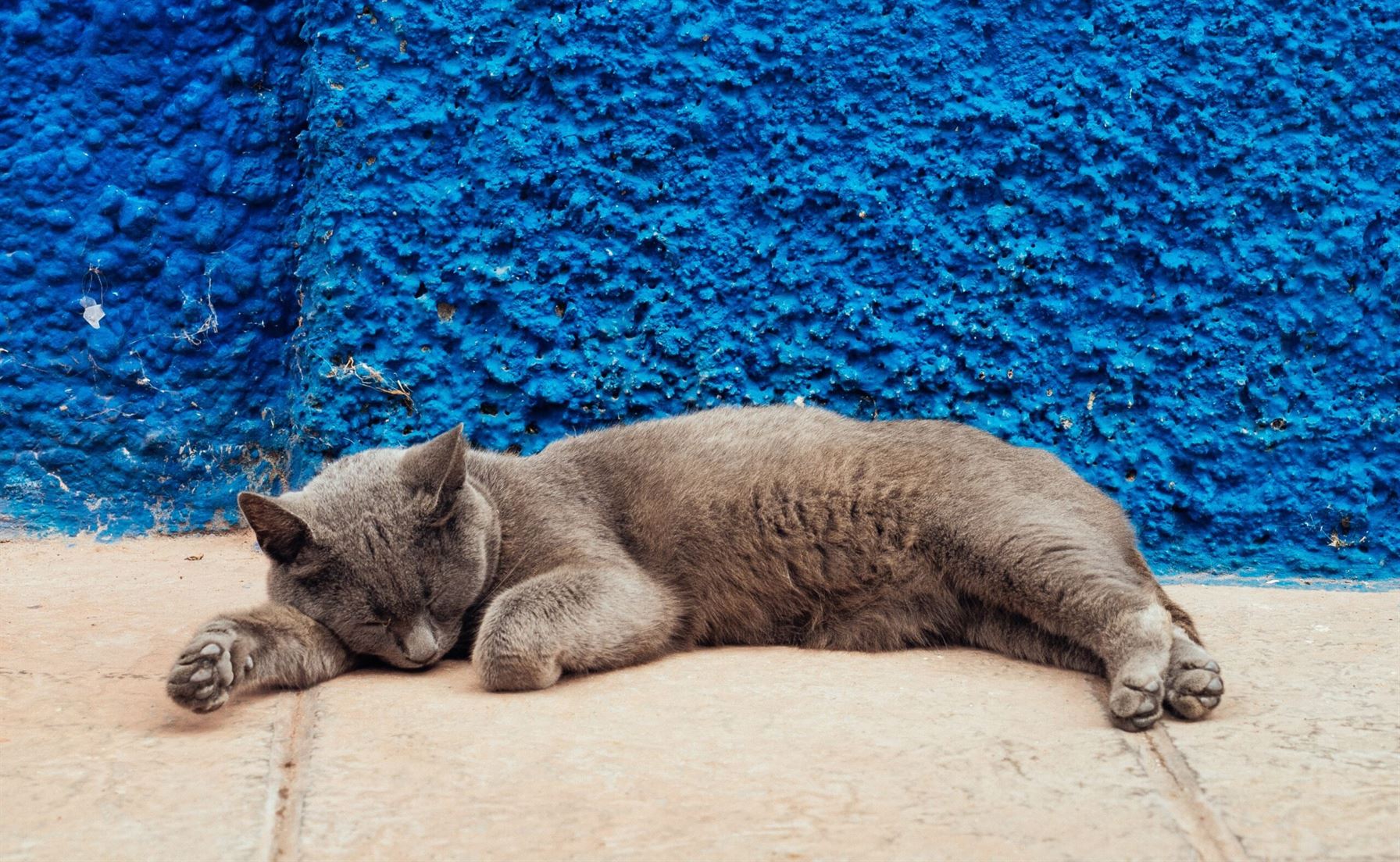Meet The Breeds: Russian Blue Cat

Sometimes called Archangel Blue or Archangel Cat, the Russian Blue Cat’s origin is traced to northern Russia, more appropriately, the Archangel Isles.
Although the exact period it came about is not precise, many believe it descended from cats of past Russian Czars. However, its development as a breed occurred majorly in Britain and Scandinavia and debuted in the first cat shows held in England in the 1880s.
Famous for its soft, silky, and dark coats, with dark gray shade and a touch of light, shimmering silver, there is no telling the beauty of these bright green eyes tabby.
You probably intend to snap up Russian Blue Cat Kittens, but do you know what your cat needs to make its life comfortable? This piece is to ensure you do by figuring out more about Russian Blue Cat breed information

What are the types of Russian Blue Cat?
There are two variant types of Russian Blue Cat. The American type, which spots a paler coat, and the English type, spotting a darker coat. A striking difference between both is that their ears are positioned differently.
Despite the dichotomy, you are sure to expect a very strong and muscular body in any Russian blue cat kitten you take home.
Are Russian Blue Cats good pets?
With its overly loyal demeanor, which makes it cling to its pet parent anywhere and demonstrates affection to everyone in the family. For people who ask “Are Russian blue cats friendly? “, the Russian Blue Cat personality is more than enough what is expected of a feline buddy.
Why would you not have one when one of the Fun facts about Russian Blue Cat is its comparison to Mona Lisa, due to a similar smiling look. If you are a busy pet parent, worry not. The breed, although very social, is capable of enjoying solitude moments by entertaining and exercising itself.
Is the Russian Blue Cat trainability capable of dissuading you from getting one? Based on these amazing fun facts about the Russian Blue, we say think again.
Did you know:
- It is playful and can play fetch if trained?
- It is very smart and can be seamlessly trained to talk, use the litter box, and scratch post?
Are Russian Blue Cats HDB approved?
The HDB doesn’t allow cats to live in flats. You should be aware that the Russian blue has been classified as a cat breed as early as the 1900s after its introduction to the United States and has been approved by the Cat Fanciers’ Association and The International Cat Association. Thus, approval of HDB is dispensable when a pet has been approved.
What health issues do Russian Blue Cats face?
The Russian Blue is usually healthy, and expect a long life span in this unique tabby within 10-20 years or longer. But, they may come up with progressive retinal atrophy (PRA), which can deteriorate its retina or the eye. It may also be down with a polycystic kidney disease (PKD), which makes its kidneys full of fluid-filled spaces, and makes working a chore. These can be nipped if you are attentive to your buddy and schedule an occasional check-up with a vet.
Attention is also required with its eating ability as it is prone to obesity. All you need is to measure its cat food to a regular twice or thrice daily.

Are Russian Blue Cats high maintenance?
Requirements to maintain these breeds are incredibly low. But know that it needs grooming, albeit minimal, needs weekly brushing and nail trimming.
To guarantee its health, you may want to invest in a toothbrush and toothpaste to keep its teeth white and fresh, as well as a moderate- toothed comb to keep its fur smooth.
You want to make your buddy comfortable. It is a given that you mentally and physically stimulate your Russian Blue with toys because it is no telling how intelligent this royal buddy is.
It is also instinctively a hunter. Ergo, it needs a feathered fishing pole toy and a scratching post to go about its activities.
However, the Russian Blue is an excessive eater and may ask for its chow all day. You don’t want to encourage this due to its likely toll on your bankroll and the likely obesity affecting your tabby. So, you should place your cat on regular feeding.
Are Russian Blue Cats aggressive?
This is not the Russian Blue’s nature at all. What you will get is a sweet and loyal buddy who will follow you around, but despite the clingy nature, they are calm. You should reciprocate and laugh with your cat, as a lack of affection makes the Russian Blue Cat kitten anxious.
You should note that it doesn’t adapt to change, such as erratic mealtimes, and can be aggravated, shy when strangers are around. However, when socialized with new faces, it shows them doting love.
It is capable of self-entertainment, such as enjoys jumping or climbing to high places, tear its toys, or eat fish pole feathers. But, it is not destructive to surrounding properties.
What are popular mixed breeds with Russian Blue Cats?
The Russian Blue Cat kitten has been instrumental in creating many cat breeds. In the US, crossbreeding with a black domestic short-hair brought about the Nebelung cat around the 1980s
There is also the Havana brown which since the 1950s resulted from planned breeding with Siamese and domestic black cats, early breeders used Siamese-type Russian Blue to breed them.
In Australia, the Russian Whites, Russian White, and Tabby Cats were developed in 1971 with a crossbreed of a white Siberian Cat and a Russian Blue Cat.
Are Russian Blue Cats hypoallergenic?
The Russian Blue sheds very little and produces a meager amount of dander (which is the leading cause of cat allergies); thus, it may be a perfect choice for pet parents that are allergic and always ask “Are Russian blue cats really hypoallergenic?”. In effect, allergy sufferers can suitably live with a Russian Blue.

Do Russian blue cats like to cuddle?
Yes, Russian Blue Cats love cuddling, playing, and even sleeping with you.
Are Russian blue cats skinny?
They are slim with beautiful green eyes weighing 7-15 pounds. However, be cautious as they are prone to obesity.
Do Russian blue cats meow a lot?
The Russian blue cat speaks softly and in quiet meows especially when it wants you to know food and water, rather than be wild about it.
Why does my Russian blue cat bite me?
Russian Blue Cats are not aggressive so when they bite, you have to visit your vet as it is a sign of internal pain or injury.
Do all Russian blue cats have green eyes?
Yes, these beautiful cats are characterized by their green eyes.
Do Russian blue cats need baths?
They don’t need many baths, they are clean pets. You can be bathed in case of being dirty, having specific infections, or parasites.
What is the best food for Russian blue cats?
Russian Blue Cats love eating proteins so be sure about the quality of the protein, check Perromart store for buying the best food brands for your kitten.
Can you let Russian blue cats outside?
Yes, you can do this but It is not the best treatment for your cat. Outside they may face harsh climates or unkind people. Also, neglecting your Russian Blue Cat could make it a little anxious.
Are Russian blue cats good for first time owners?
Regarding difficulty level for first-time owners (on a scale of 1-10 paws), Russian Blue Cats are an excellent choice for novice owners, they are lovable, playful, and entertaining.
Do Russian blue cats have blue eyes?
No, Russian Blue Cats are born with yellow eyes that turn by time into the green.
Are Russian blue cats expensive?
Russian Blue Cat costs between $800-$1,200

How much do Russian Blue kittens cost?
Russian Blue Cat Kitten costs between $400–$600
How do you get a Russian Blue kitten?
The best way to get this little kitten is to search for a reputable breeder near you to make sure that you got the best Russian Blue Kitten.
Are Russian Blues good indoor cats?
Yes, they are quiet and moderate active cats that is why they don’t mind staying home.
Do Russian blue cats go outside?
You can let your Russian Blue Cat outside in case of walking in an enclosed yard or being under your supervision in order not to put your cat in danger.
Can Russian blue cats be left alone?
Yes, they are independent cats so if you are busy working, you can leave it home until you come back home.
How can I tell if my blue Russian cat is real?
First, you have to search for a reputable breeder, then compare your cat with the standard qualities and characteristics of the Russian Blue Cat such as length, weight, eye color. Finally, check its pedigree papers
If you need a gentle, gorgeous, and loving feline buddy, the Russian Blue Cat should appropriately be considered.
It is a breed that accepts both its pet parents, outsiders, and other pets, including dogs.







